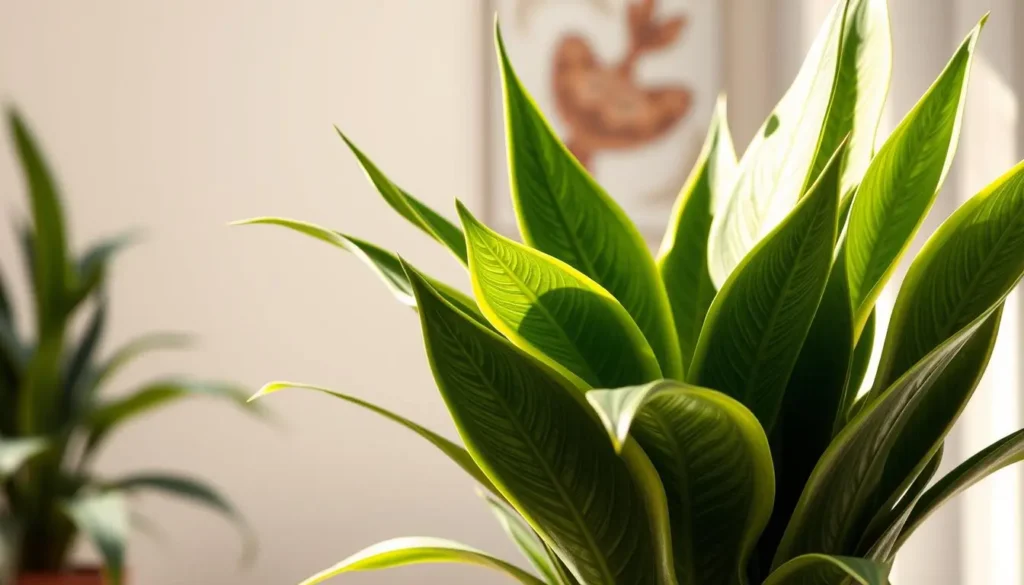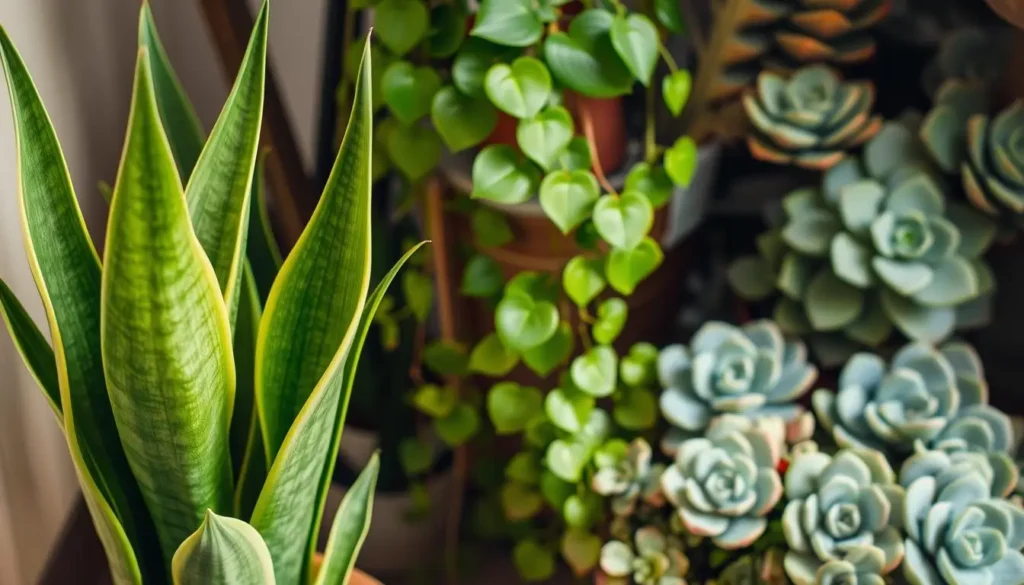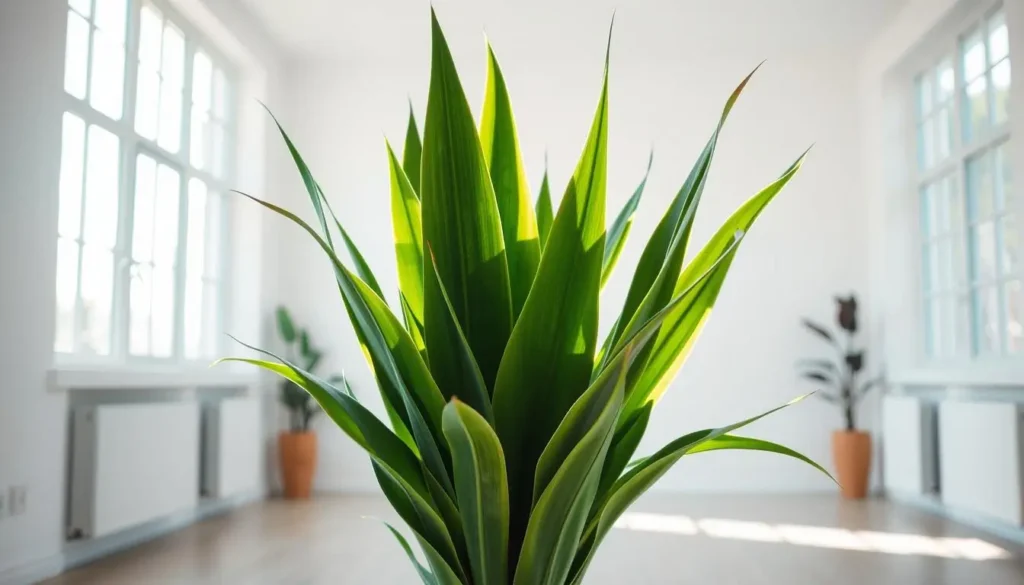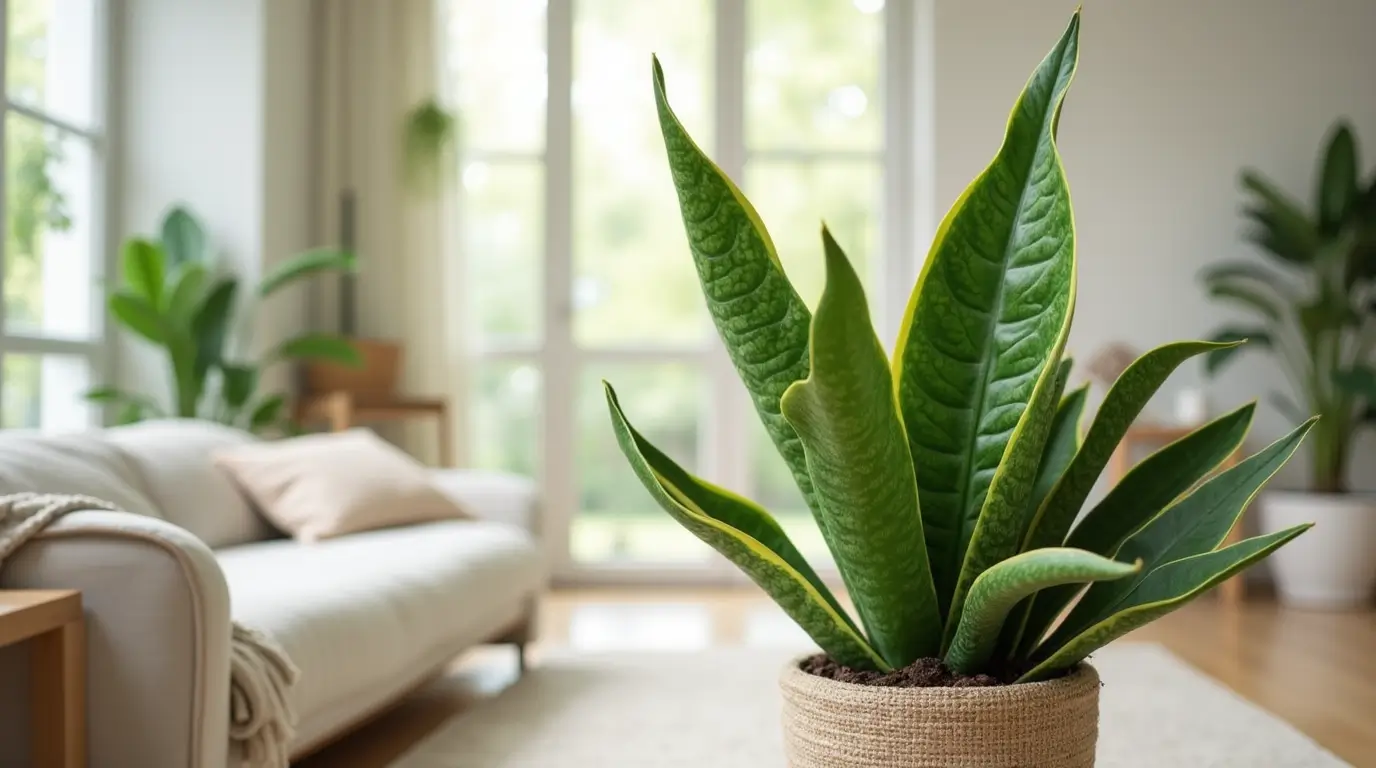Snake Plant Benefits: Essential Reasons to Own One Now.
Imagine a plant that grows well in busy spots, cleans the air, and doesn’t need much care. That’s the snake plant. In 2023, over 3 million U.S. homes welcomed Sansevieria, loving its mix of beauty and toughness. These plants fit into any space, whether you live in a small city apartment or a big suburban house.

Key Takeaways
- Snake plants clean indoor air by removing toxins like formaldehyde and benzene.
- They require minimal water and light, making them ideal for busy lifestyles.
- These plants release oxygen at night, improving sleep quality.
- Snake plants enhance home decor with sleek, modern looks.
- One plant per 100 square feet boosts air quality in most rooms.
What Makes Snake Plants Special in the Indoor Plant World
Snake plants are unique in the indoor plant world. They come from dry, sunny areas of West Africa. This background helps them thrive in tough spots, making them great indoor friends.

Origins and Characteristics of Snake Plants
These plants grow tall with stiff, sword-like leaves. Their leaves can hold water for weeks. This means they’re easy to care for, perfect for gardening newbies.
Why Snake Plants Have Grown in Popularity
City folks and busy people love them. They do well in low light and need water only sometimes. Their modern look also fits well in homes, adding beauty without effort.
Different Varieties of Snake Plants Available
- ‘Laurentii’: Yellow-edged leaves for vibrant accents.
- ‘Moonshine’: Silvery leaves ideal for soft, neutral rooms.
- Cylindrical: Rounded leaves add unique texture.
- Dwarf varieties: Compact sizes for small spaces like desks or shelves.
Each variety has the same easy care needs. You can pick one that matches your style and enjoy all the snake plant benefits.
Snake Plant Benefits for Air Purification
Snake plants are more than just pretty—they clean the air. As an air purifying plant, they stand out. They make indoor air healthier.
How Snake Plants Filter Toxins
These plants soak up pollutants like formaldehyde and benzene. During photosynthesis, they take in toxins. Then, microbes break them down at night.
At night, they release oxygen. This is different from most plants. It makes them perfect for bedrooms or living rooms.

The NASA Clean Air Study Results
In 1989, NASA found snake plants to be a nasa approved plant. They remove up to 87% of indoor xylene and toluene in 24 hours. They also handle trichloroethylene well.
This made them great for space habitats. It shows their strength and efficiency.
Comparing Snake Plants to Other Air Purifying Plants
- Nighttime oxygen release: Snake plants produce oxygen at night, unlike peace lilies or spider plants.
- Efficiency: Remove formaldehyde faster than pothos (up to 10% more in 12 hours).
- Drought tolerance: Outperform many air purifying plants in low-water conditions while maintaining purification rates.
For places with little light or busy lives, snake plants are a great choice. They improve air quality without needing much care.
Low Maintenance: The Perfect Plant for Busy Lifestyles
If you’re always on the go, the snake plant is a lifesaver. It’s a low maintenance indoor plant that doesn’t need much care. Just water it every 2-6 weeks, letting the soil dry out completely to avoid root rot.
It can handle different light levels, from low to bright indirect. But it loves a sunny spot. You don’t need special tools or to check on it every day. Plus, it rarely gets pests.
Key perks of this low maintenance indoor plant:
- Survives 3–6 weeks without water
- Thrives in average room temperatures (65–85°F)
- Decades-long lifespan with basic care
No green thumb? No worries. This plant is perfect for apartments, offices, or homes where time is tight. It’s your reliable green friend without the hassle.
Improving Your Indoor Air Quality with Snake Plants
Snake plants are not just easy to care for. They also clean the air in your home. They do this by removing toxins and improving the air quality. This makes your home a healthier place to be.
Oxygen Production During Nighttime
While most plants stop making oxygen at night, snake plants keep going. They use a special way of photosynthesis called CAM. This lets them make oxygen even when it’s dark.
This is great for your bedroom. It helps you sleep better by getting rid of carbon dioxide.
Removing Common Household Toxins
Snake plants are good at getting rid of bad stuff in the air. They take in formaldehyde from furniture and VOCs from cleaning products. These come from things like paint, electronics, and synthetic fabrics.
A NASA study found that snake plants can remove up to 87% of indoor toxins in just 24 hours.
Ideal Number of Snake Plants Per Room
To get the most out of snake plants, follow NASA’s advice. They say to have one medium-sized plant for every 100 square feet. Here’s how to place them for the best effect:
- Put 2-3 plants in a 300-square foot living room.
- Place them near furniture or electronics to catch the bad air.
By using these tips, you can keep your home’s air clean and safe. Whether you’re sleeping, relaxing, or working, snake plants are working hard to protect your air.
How Snake Plants Can Help You Sleep Better
Snake plants help you sleep better by making your bedroom a better place. They release oxygen at night, helping you breathe easier and sleep deeper. They also clean the air of toxins like formaldehyde, which can mess with your sleep.
They also help control the humidity in your room. Keeping the air moist between 40-60% helps prevent stuffy noses and congestion. This makes it easier to sleep through the night without interruptions.
- Place 1-2 plants 1-2 feet from your bed
- Avoid direct drafts to maintain stable humidity
| Benefit | Snake Plant’s Role |
|---|---|
| Oxygen | Continuous night release supports breathing |
| Allergens | Removes irritants linked to nighttime coughing |
| Stress | Calming presence lowers anxiety before bed |
A 2019 study in the Journal of Physiological Anthropology found bedrooms with plants reported 15% less stress hormones, improving sleep onset time.
Snake plants are easy to care for, so they won’t add stress to your life. Their calm presence by your bed creates a peaceful sleep environment. This helps you sleep better without needing to worry about them.
Snake Plants as Natural Humidifiers in Your Home
Did you know your snake plant can act as a natural humidifier? These tough plants quietly add moisture to your home. They do this through a process called transpiration. Unlike electric humidifiers, they release clean vapor without mold risks, making them a smart choice for dry spaces.
The Science Behind Plant Transpiration
Snake plants release water vapor through tiny leaf openings called stomata. They add humidity to your home, even though they transpire slower than tropical plants. This is because they come from the desert. They work all day, turning stored water into moisture in the air.
Benefits of Natural Humidity from Snake Plants
- Reduces dry skin and hair irritation
- Prevents wood furniture from cracking
- Cuts static cling on clothes
- Maintains 40-60% humidity ideal for health
Traditional humidifiers can grow mold if not cleaned, but snake plants emit pure vapor directly from their leaves. No cleaning required!
Where to Place Snake Plants for Best Results
Maximize moisture by following these tips:
- Cluster 2–3 plants in dry rooms like bedrooms or offices
- Position near heating vents to counteract dry heat
- Use wide, shallow pots to increase soil surface area for evaporation
Pairing snake plants with other greenery creates a natural humidifying system. Ideal for those seeking low-effort, long-term humidity control.
Why Snake Plants Are Perfect for Beginners
Snake plants are the best for beginners because they can handle neglect. They are perfect for anyone new to gardening or who has struggled with houseplants. Here’s why they’re so easy to care for:
- Forgiving watering habits: Snake plants can go weeks without water. Their thick leaves store moisture, making them easy to care for.
- Light flexibility: They do well in bright light or dim corners. No need for special grow lights.
- Self-explanatory problems: Yellow leaves mean too much water. Crispy edges mean too much sun. These signs help you fix problems fast.
| Aspect | Snake Plant | Other Houseplants |
|---|---|---|
| Water Needs | Once every 2-6 weeks | Weekly or biweekly |
| Pest Resistance | Naturally pest-resistant | Regular pest-prone |
| Recovery Time | Bounces back quickly from neglect | Slow recovery or permanent damage |
“90% of first-time plant owners keep their snake plants alive for over a year.” – National Gardening Association Study
Even those who thought they had a “black thumb” can grow snake plants. Their hardiness boosts confidence, encouraging you to try more challenging plants. Start with a snake plant and discover the joy of gardening.
Decorative Benefits and Styling Your Space with Snake Plants
Snake plants do more than clean the air—they also make your space look great. Their tall, striking leaves can instantly brighten up any room. They fit into any style, from modern and simple to bold and eclectic, while also being practical.
Modern Minimalist Styling Options
Snake plants are perfect for modern homes. Their tall shape looks great against simple colors. Here are some ideas:
- Mid-century modern: Pair with a tapered ceramic pot
- Scandinavian: Use a pale terracotta planter
- Contemporary: Elevate with a floating wall mount
Snake Plants in Different Room Settings
Each room can be styled differently with snake plants:
| Room | Best Variety | Design Tip |
|---|---|---|
| Living Rooms | Sansevieria cylindrical | Anchor corner groupings |
| Bedrooms | Sansevieria trifasciata | Place bedside to enhance sleep quality |
| Offices | Golden Hahnii | Boost focus on minimalist desks |
| Bathrooms | Bird’s Nest Snake Plant | Use in glass containers for humidity-loving spaces |
Container and Display Ideas
Get creative with your plant displays:
- Industrial: Matte black pots for edgy vibes
- Boho: Woven seagrass baskets
- Urban: Concrete planters for a grounded look
Try stacking different heights on stands or group them to divide spaces naturally. Their unique shapes can be the highlight of any room without taking over.
Essential Snake Plant Care Tips for Maximum Benefits
Learning snake plant care helps these plants stay healthy and keep your air clean. Follow these steps to avoid common mistakes and keep your plant thriving:
- Water only when soil is completely dry—typically every 2-6 weeks. Overwatering causes root rot.
- Place in bright, indirect light. They tolerate low light but grow slower in dark rooms.
- Use well-draining soil. Mix with perlite or sand to prevent waterlogging.
Keep temperatures between 70-90°F. Most homes stay within this range, but avoid drafts below 55°F. Fertilize lightly 2-3 times yearly during spring and summer. Repot every 2-3 years when roots fill the pot.
“A stressed plant can’t clean the air as effectively. Proper care boosts its natural abilities,” says indoor plant expert Dr. Linda Green.
Brown leaf tips? Reduce fluoride in water by using filtered or distilled options. Drooping leaves signal overwatering—adjust your schedule. Check for spider mites by wiping leaves with a damp cloth weekly.
In winter, cut watering to once a month. Let plants dry out longer between drinks. Propagate via leaf cuttings in soil or water during spring. Healthy plants mean cleaner air and fewer maintenance headaches.
Conclusion: Why Adding a Snake Plant to Your Home is a Smart Choice
Snake plants are amazing for your home. They look good and clean the air. They remove toxins and make oxygen at night, helping you sleep better.
They’re easy to care for, making them great for anyone. Even if you’ve had trouble with plants before, snake plants are different. They’re not just pretty; they also clean the air.
They’re cheaper than air purifiers but do the same job. They work well in any room, from bright kitchens to dark corners. They’re like silent heroes, making your air cleaner without you even noticing.
Even one snake plant can make a big difference. It starts a cycle of cleaner air and better sleep. So, don’t worry if you’ve had trouble with plants before.
Snake plants are forgiving and stylish. They fit with any decor, making your home look better. Start with one in your favorite room. Once you see the difference, you’ll want more.
Your home will thank you for adding a snake plant. It’s a simple way to make your space better. Start today and see the change for yourself.
FAQ
What are the key snake plant benefits?
Snake plants clean the air by removing toxins. They improve indoor air quality and act as natural humidifiers. They are also easy to care for, making them great for busy people.
How do snake plants filter toxins from the air?
Snake plants take in pollutants through their leaves. They then break down these harmful substances. This process removes toxins like formaldehyde and benzene from your home.
Can snake plants improve my sleep quality?
Yes! Snake plants release oxygen at night. This helps improve sleep by increasing oxygen levels in your bedroom. It also reduces allergens that can disrupt sleep.
Are snake plants easy to care for?
Absolutely! Snake plants are perfect for beginners. They need little water and can handle different light conditions. They’re great for those who don’t have a green thumb.
What is the ideal number of snake plants per room?
For best air filtration, have one medium snake plant for every 100 square feet. Placing them in different spots in your home boosts their air cleaning power.
How do snake plants help with indoor humidity?
Snake plants help keep humidity levels right by releasing moisture. This is good for your breathing and prevents dry skin or damaged furniture.
What varieties of snake plants are available?
You can find many snake plant varieties. There’s ‘Laurentii’ with yellow edges, ‘Moonshine’ with silver-green leaves, and more. Each variety fits different spaces and styles.
How often should I water my snake plant?
Water your snake plant every 2-6 weeks. Make sure the soil is completely dry before watering again. Avoid too much water, as it can harm the plant.
Want More Plant Tips? Follow Us!
🌿 YouTube: Watch detailed plant care tutorials.
📌 Pinterest: Discover stunning plant decor ideas.
🎥 TikTok: Get quick and fun plant hacks.
Join our plant-loving community today!”

